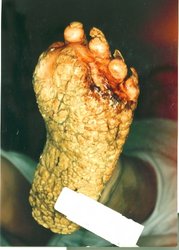A 40-year-old woman with no significant past medical history presented with asymptomatic lesions on the fingers and palms of the hands (see the accompanying figure). The lesions had been present for as long as she could remember. No lesions were apparent on the soles of the feet. She reported no similar lesions in anyone in her family.
Examination revealed numerous punctate depressions limited to the fingers and creases of the palms of the hands.
Question
Given the physical examination and the appearance of the lesions, which one of the following is the most likely diagnosis?
Discussion
The answer is C: keratosis punctata. Keratosis punctata, which is limited to the palmar creases, (KPPC) occurs almost exclusively in blacks.1-3 Another variation of keratosis punctata involves the palms of the hands and the soles of the feet.
The differential diagnosis of KPPC includes porokeratosis and verrucae. In contrast to KPPC, the lesions of porokeratosis involve the entire palmoplantar surfaces.
Verrucae, or warts, can present as firm, keratotic papules on the palms of the hands. However, it would be highly unlikely for all of the warts to be limited to the creases.
Keratoderma is a diffuse thickening of the palms of the hands and the soles of the feet. This condition may be inherited or acquired.
Keratosis pilaris is an extremely common skin disorder that is often associated with atopic dermatitis. Patients with keratosis pilaris present with follicular papules that occur on the posterior proximal arms or thighs and may vary from skin-colored to erythematous. The lesions may be asymptomatic to slightly pruritic.
The diagnosis of keratosis punctata is based on the history, physical examination and biopsy. Physical examination reveals 1- to 4-mm keratotic papules on the palmar, metacarpophalangeal and interphalangeal creases of the hands. The papules are usually not tender and leave epidermal depressions or pits when the lesions fall out or are removed. Histologic examination reveals a cup-like depression with overlying hyperkeratosis.1,2 The dermis is normal, although a mild lymphocytic infiltrate may occasionally be present.(1)
KPPC is such a common finding among the black population that some authors describe it as a normal variant. Treatment is aimed at management of the hyperkeratosis. Keratolytic preparations containing salicylic acid in a propylene glycol gel may be used to remove the stratum corneum. Ointments and creams also can be used to soften the skin. Isotretinoin (Accutane) in doses of 0.5 to 2 mg per kg per day has been shown to markedly reduce the hyperkeratosis but would require the usual precautions associated with its use.
REFERENCES
(1.) Penas PF, Rios-Buceta L, Sanchez-Perez J, Dorado-Bris JM, Aragues M. Keratosis punctata of the palmar creases: case report and prevalence study in Caucasians. Dermatology 1994;188:200-2.
(2.) Ortega M, Sanchez-Conejo-Mir J, Quintana del Olmo J, Camacho F. Keratosis punctata of the palmar creases. J Cutan Pathol 1989;16:109-11.
(3.) Rustad OJ, Vance JC. Punctate keratoses of the palms and soles and keratotic pits of the palmar creases. J Am Acad Dermatol 1990;22:468-76.
COPYRIGHT 2001 American Academy of Family Physicians
COPYRIGHT 2001 Gale Group



